Everything About Thread Veins: Causes, Treatments, and What to Expect
Thread veins—also known as spider veins or telangiectasia—are a common cosmetic concern that affects many people, especially as they age. These tiny, visible blood vessels often appear just beneath the skin’s surface and can cause self-consciousness or discomfort, even though they are typically harmless.
At The Devonshire Clinic, we offer expert insight and treatment options to safely and effectively reduce the appearance of thread veins. Whether you’re dealing with facial veins or leg veins, here’s everything you need to know.
What Are Thread Veins?
Thread veins are small, dilated blood vessels that appear red, blue, or purple and are typically found on the face, legs, and chest. They are called “thread veins” because of their fine, thread-like appearance and are usually close to the skin’s surface.
Unlike varicose veins, thread veins are not raised or twisted and don’t generally cause physical discomfort—although they may be associated with other underlying venous issues, especially on the legs.

What Causes Thread Veins?
There are several factors that can contribute to the development of thread veins:
- Age: As skin and blood vessels become more fragile over time.
- Sun exposure: UV damage weakens blood vessels, especially on the face.
- Genetics: A family history can increase your likelihood.
- Hormonal changes: Pregnancy, menopause, or contraceptive use can trigger them.
- Lifestyle factors: Prolonged standing, alcohol consumption, or high-pressure exercise.
- Skin trauma: Previous injuries or treatments may lead to broken capillaries.
- Medical conditions: Rosacea or other inflammatory skin conditions can be associated with thread veins.
Where Do They Commonly Appear?
Thread veins can develop anywhere on the body but are most often found on:
- Face (nose, cheeks, chin)
- Legs (thighs, calves, ankles)
- Chest and décolletage
Facial thread veins are often linked to rosacea or sun exposure, while leg thread veins may be connected to underlying vein health.
Can You Prevent Thread Veins?
While not always preventable, you can take steps to reduce your risk or delay their appearance:
- Use broad-spectrum SPF daily, especially on the face
- Avoid excessive heat (hot showers, steam rooms)
- Limit alcohol consumption
- Manage underlying skin conditions like rosacea
- Avoid standing or sitting for prolonged periods
- Wear compression stockings if you’re prone to leg vein issues
Thread Vein Treatments at The Devonshire Clinic
We offer advanced, non-surgical treatments designed to safely and effectively reduce or eliminate thread veins:
1. Laser Therapy
- Targets and collapses visible veins with pulses of light
- Ideal for facial thread veins
- Minimal discomfort and downtime
- Typically requires a course of treatments for best results
2. Microsclerotherapy
- Gold standard for leg thread veins
- A fine needle is used to inject a sclerosing solution into the vein, causing it to collapse and fade
- Safe, effective, and performed by a trained specialist
- Multiple sessions may be required depending on the extent of the veins
3. IPL (Intense Pulsed Light)
- Can be used for finer facial veins or alongside rosacea treatment
- Improves overall skin tone and texture
Why Choose The Devonshire Clinic?
At The Devonshire Clinic, our Consultant Dermatologists combine medical expertise with the latest in vein treatment technology. We provide:
- Personalised treatment plans tailored to your needs
- Medical-grade devices and procedures
- Safe, discreet, and comfortable care in our central London clinic
Final Thoughts
Thread veins are a common cosmetic concern, but they don’t have to be permanent. With professional treatments available at The Devonshire Clinic, you can safely and effectively restore clearer, more even-toned skin. Book your consultation today and start your personalised treatment plan with London’s trusted skin specialists.